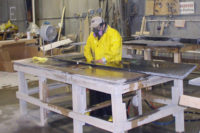I’m all for safety — it is one of the most important things that we can promote here at Stone World — but there is a lack of evidence out there as to why this was proposed. In fact, OSHA’s own report states that from 1968 to 2002, the number of silicosis deaths among those aged 15 or higher decreased by 93%. It then utterly dismisses this total, however, based on a 1989 study that cites “underreporting” of silicosis cases. So wait, just so I understand, this “underreporting” phenomenon started in 1968?
Rather, as supporting evidence for its proposal, OSHA cites a number of studies, including ones conducted on granite industry workers in the U.S., Canada and Europe. The most recent of these studies was conducted in 2007, while others date as far back as 1983, and the scientific justification for changing the standard at this time is not at all clear.
There are many other inconsistencies in OSHA’s report covered in my article on page 46, but one of the points that irritates me the most is that it states that the new standard will affect 1,943 stone processors in the U.S. That figure is based on the amount of companies that are classified as “Cut stone and stone product manufacturing” by the U.S. Census Bureau.
Based on this report — and my conversations with people from OSHA as well as fabricators across the country — it is clear that OSHA is grossly underestimating the size of our industry. I’ve asked professionals in occupational safety about this, and they have agreed with my assessment. OSHA doesn’t know the size of the industry, and it really isn’t trying to find out.
This is a bad thing for many reasons. For one, that means that no one is monitoring the health and welfare of the people working for the shops that OSHA ignores. Isn’t that why OSHA exists in the first place, to make sure that people working under potentially hazardous conditions are protected?
Secondly, it is already tough enough for the above-board shops to compete with low-ball fabricators working out of an unsafe space (or on the customer’s lawn) with no insurance, legal employees or licensing. If OSHA simply keeps hammering the same 1,943 shops, those businesses will be waving the white flag sooner or later because the playing field won’t just be unlevel; it will be impossible.
As an organization, OSHA needs to focus more on learning more about the size and makeup of our industry and less on increasing regulations on the legitimate, above-board shops who care about their workers and are doing everything they can to be in compliance. Getting back to my original point, there is no scientific evidence to change the silica standard, and statistics over the past 40-plus years would agree with me.
OK, now here’s a piece of good news: OSHA actually cares what people think. Shop owners who have worked with OSHA said they found their dialogue to be collaborative. There is still time for members of the natural stone industry to reach out to OSHA and tell them that the proposed silica standard is wrong. To read about the rule, visit https://www.osha.gov/silica/. The “Public Participation” tab allows for commentary on the proposed rule.
While you’re at it, maybe let them know about that illegal shop down the street from you, OK? I’ve seen enough devaluing of our product, and it’s time to do something about it.


